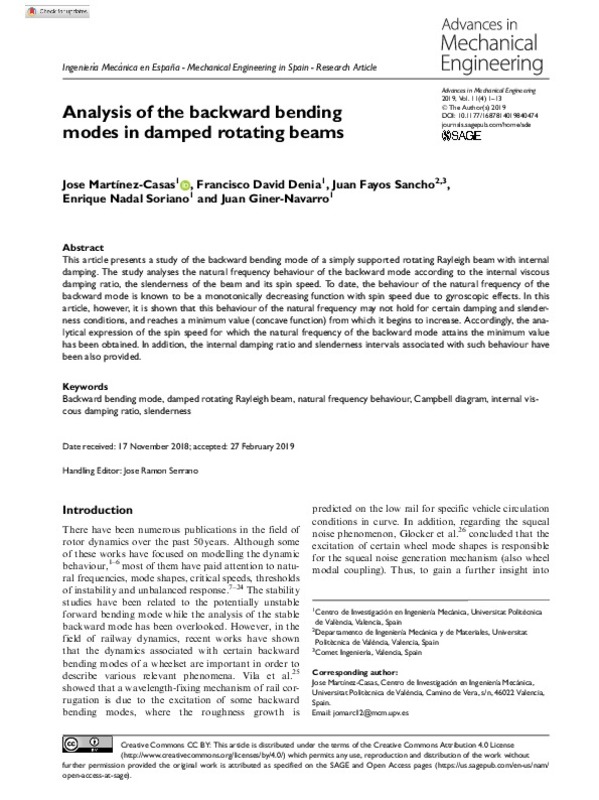Zorzi, E. S., & Nelson, H. D. (1977). Finite Element Simulation of Rotor-Bearing Systems With Internal Damping. Journal of Engineering for Power, 99(1), 71-76. doi:10.1115/1.3446254
Ku, D.-M. (1998). FINITE ELEMENT ANALYSIS OF WHIRL SPEEDS FOR ROTOR-BEARING SYSTEMS WITH INTERNAL DAMPING. Mechanical Systems and Signal Processing, 12(5), 599-610. doi:10.1006/mssp.1998.0159
Dimentberg, M. F. (2005). Vibration of a rotating shaft with randomly varying internal damping. Journal of Sound and Vibration, 285(3), 759-765. doi:10.1016/j.jsv.2004.11.025
[+]
Zorzi, E. S., & Nelson, H. D. (1977). Finite Element Simulation of Rotor-Bearing Systems With Internal Damping. Journal of Engineering for Power, 99(1), 71-76. doi:10.1115/1.3446254
Ku, D.-M. (1998). FINITE ELEMENT ANALYSIS OF WHIRL SPEEDS FOR ROTOR-BEARING SYSTEMS WITH INTERNAL DAMPING. Mechanical Systems and Signal Processing, 12(5), 599-610. doi:10.1006/mssp.1998.0159
Dimentberg, M. F. (2005). Vibration of a rotating shaft with randomly varying internal damping. Journal of Sound and Vibration, 285(3), 759-765. doi:10.1016/j.jsv.2004.11.025
Vatta, F., & Vigliani, A. (2008). Internal damping in rotating shafts. Mechanism and Machine Theory, 43(11), 1376-1384. doi:10.1016/j.mechmachtheory.2007.12.009
Rosales, M. B., & Filipich, C. P. (1993). Dynamic Stability of a Spinning Beam Carrying an Axial Dead Load. Journal of Sound and Vibration, 163(2), 283-294. doi:10.1006/jsvi.1993.1165
Mazzei, A. J., & Scott, R. A. (2003). Effects of internal viscous damping on the stability of a rotating shaft driven through a universal joint. Journal of Sound and Vibration, 265(4), 863-885. doi:10.1016/s0022-460x(02)01256-7
Ehrich, F. F. (1964). Shaft Whirl Induced by Rotor Internal Damping. Journal of Applied Mechanics, 31(2), 279-282. doi:10.1115/1.3629598
Vance, J. M., & Lee, J. (1974). Stability of High Speed Rotors With Internal Friction. Journal of Engineering for Industry, 96(3), 960-968. doi:10.1115/1.3438468
Vila, P., Baeza, L., Martínez-Casas, J., & Carballeira, J. (2014). Rail corrugation growth accounting for the flexibility and rotation of the wheel set and the non-Hertzian and non-steady-state effects at contact patch. Vehicle System Dynamics, 52(sup1), 92-108. doi:10.1080/00423114.2014.881513
Glocker, C., Cataldi-Spinola, E., & Leine, R. I. (2009). Curve squealing of trains: Measurement, modelling and simulation. Journal of Sound and Vibration, 324(1-2), 365-386. doi:10.1016/j.jsv.2009.01.048
Bauer, H. F. (1980). Vibration of a rotating uniform beam, part I: Orientation in the axis of rotation. Journal of Sound and Vibration, 72(2), 177-189. doi:10.1016/0022-460x(80)90651-3
Shiau, T. N., & Hwang, J. L. (1993). Generalized Polynomial Expansion Method for the Dynamic Analysis of Rotor-Bearing Systems. Journal of Engineering for Gas Turbines and Power, 115(2), 209-217. doi:10.1115/1.2906696
Hili, M. A., Fakhfakh, T., & Haddar, M. (2006). Vibration analysis of a rotating flexible shaft–disk system. Journal of Engineering Mathematics, 57(4), 351-363. doi:10.1007/s10665-006-9060-3
Young, T. H., Shiau, T. N., & Kuo, Z. H. (2007). Dynamic stability of rotor-bearing systems subjected to random axial forces. Journal of Sound and Vibration, 305(3), 467-480. doi:10.1016/j.jsv.2007.04.016
Wang, J., Hurskainen, V.-V., Matikainen, M. K., Sopanen, J., & Mikkola, A. (2017). On the dynamic analysis of rotating shafts using nonlinear superelement and absolute nodal coordinate formulations. Advances in Mechanical Engineering, 9(11), 168781401773267. doi:10.1177/1687814017732672
Lee, C.-W. (1993). Vibration Analysis of Rotors. Solid Mechanics and Its Applications. doi:10.1007/978-94-015-8173-8
Genta, G. (1999). Vibration of Structures and Machines. doi:10.1007/978-1-4612-1450-2
Cheng, C. C., & Lin, J. K. (2003). Modelling a rotating shaft subjected to a high-speed moving force. Journal of Sound and Vibration, 261(5), 955-965. doi:10.1016/s0022-460x(02)01374-3
[-]









